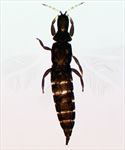
Female

Antenna
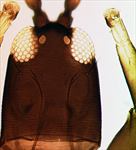
Head & fore tarsus

Pronotum
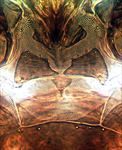
Prosternites
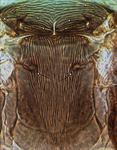
Mesonotum & metanotum
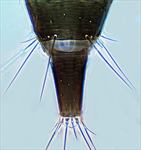
Female segments IX–X (tube)

Fore wing
Both sexes fully winged. Body brown with reddish purple internal pigment; legs brown, fore tarsi and apices of fore tibiae yellow; antennal segment III largely yellow, IV–VI yellow at base; major setae light brown; fore wings pale, scarcely shaded at base. Antennae 8-segmented; segment III with one sense cone, IV with 4 sense cones, VIII short and broad at base. Head distinctly longer than wide; maxillary stylets retracted to eyes, about one third of head width apart medially; eyes not prolonged ventrally; postocular setae weakly capitate, shorter than eye length. Pronotum with 5 pairs of weakly capitate major setae; prosternal basantra and ferna well developed, mesopresternum reduced to paired lateral triangles although these are sometimes joined medially. Fore tarsus with small pointed tooth. Metanotum closely striate medially. Fore wing constricted medially, with about 10 duplicated cilia; sub-basal seta S3 pointed and much longer than capitate S1 and S2. Tergite IX setae S1 acute, about as long as tube.
Male similar to female, but fore tarsal tooth larger; tergite IX setae S2 short and stout; sternite VIII with no pore plate; pseudovirga of aedeagus slender.
The genus Leptothrips is related to Haplothrips, but the metanotal sculpture is closely striate not reticulate, and larvae and adults usually have extensive purple internal pigment. Currently, 30 species are listed under Leptothrips, all from the Americas. Johansen (1987) described 22 new species in the genus, with 11 Leptothrips recorded from California. However, Mound & O'Donnell (2017) placed nine species into synonymy and recognised only 15 Leptothrips species from North America of which nine are reported from California. Amongst these nine, distalis is one of three species in which females have a small tooth on the inner margin of the fore tarsus; it differs from the other two, fasciculatus and purpuratus, in having duplicated cilia present on the fore wings.
Presumably predatory on small arthropods, adults have been taken from various desert shrubs, and Cott (1956) reported large numbers on a species of Atriplex [Chenopodiaceae].
Widespread in western USA, from Nevada, North Dakota, California, Montana, Utah, and New Mexico. L. pristinus was described from Baja California.
PHLAEOTHRIPIDAE, PHLAEOTHRIPINAE
Leptothrips distalis (Hood)
Haplothrips distalis Hood, 1925: 103
Zygothrips californicus Mason, 1927: 156
Leptothrips pristinus Johansen, 1987: 33.
Cott HE (1956) Systematics of the suborder Tubulifera (Thysanoptera) in California. University of California, Berkeley, Publications in Entomology 13: 1–216.
Johansen RM (1987) El genero Leptothrips Hood, 1909 (Thysanoptera: Phlaeothripidae) en el continente Americano: su sistematica, filogenia, biogeografia, biologia, conducta y ecologia. Monografias del Instituto de Biologia. Universidad Nacional de Mexico 3: 1–246.
Mound LA & O’Donnell CA (2017) Predation, phytophagy and character state confusion among North American species of the genus Leptothrips (Thysanoptera: Phlaeothripinae). Zootaxa 4294 (3): 301–315.